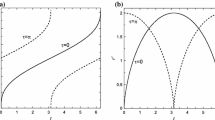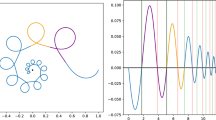Abstract
We systematically investigate the rectilinear non-collision motion, i.e., the rectilinear one with C > 0, where C is the angular momentum integral. This kind of motion appears in stellar dynamics when considering encounters of stars. For a short enough segment of a star's path, it is a very good approximation to the real motion of the star. Moreover, we derive also an analogue to Kepler's equation for this motion, and, considering the barycentric orbits of the stars, we find their minimal mutual distance.
Similar content being viewed by others
References
Agekjan, T. A. and Ogorodnikov, K. F.: 1974, Solar Neighbourhood as the Local Macroscopic Volume Element within the Galaxy, Highlights in Astronomy Vol. 3, Reidel, Dordrecht, 451.
Aitken, R. G.: 1964, The Binary Stars, Dover Publ. Inc., NY (originally published in 1918).
Alksnis, A. and Michulis, A.: 1952, ‘On the space motion of three stars from the main sequence’, Astron. Zh. 29(2), 215, (in Russian).
Bailey, M. E.: 1983, ‘The structure and evolution of the solar system comet cloud’, Mon. Not. R. Astron. Soc. 204, 603.
Danby, J. M. A.: 1987, ‘The solution of Kepler's equation, III’, Celest. Mech. 40, 303.
Danby, J. M. A. and Burkardt, T. M.: 1983, ‘The solution of Kepler's equation, II’ Celest. Mech. 31, 95.
Feller, W.: 1950, ‘An introduction to probability theory and its applications’, Vol. I, Wiley, NY, p. 120.
Garcia-Sanchez, J., Preston, R. A., Jones, D. L., Weissman, P. R., Lestrade, J. F., Latham, D.W. and Stefanik, P. R.: 1999, ‘Stellar encounters with the Oort cloud based on Hipparcos data, Astr. J. 117, 1042.
Gliese, W. and Jahreiß, H.: 1991, ‘Preliminary version of the Third Catalogue of Nearby Stars’, Astron. Rechen-Inst., Heidelberg (CNS3).
Herrick, S.: 1945, ‘Nearly parabolic and nearly rectilinear orbits’, Astr. J. 51, 123.
Jeans, J. H.: 1919, Problems of cosmogony and stellar dynamics, Cambridge Univ. Press, p. 225.
Jeans, J. H.: 1928, Astronomy and Cosmogony, Cambridge Univ. Press, p. 317 (now available through Dover Publ. Inc., NY 1961).
Landau, L. D.: 1937, ‘The Boltzmann equation for a coulomb interactions’, Zh. eksper. teor. fiziki 7(2), 203, (in Russian).
Makover, S. G.: 1964, ‘Perturbations of comets by fixed stars’, Bull. Inst. Teor. Astron. 8, 525 (in Russian).
Matthews, R. A. J.: 1994, ‘The close approach of stars in the solar neighbourhood’, Quart. J. Roy Astr. Soc. 35, 1.
Müll¨äri, A. A. and Orlov, V. V.: 1996, Encounters of the sun with nearby stars, Earth, Moon, and Planets, 72, 19.
Ng, E. W.: 1979, A general algorithm for the solution of Kepler's equation for elliptic orbits, Celest. Mech. 20, 243.
Odell, A. W., Gooding, R. H.: 1986, ‘Procedures for solving Kepler's equation’, Celest. Mech. 38, 307.
Ogorodnikov, K. F.: 1965, Dynamics of Stellar Systems, Pergamon Press, Oxford, p. 107.
Oort, J. H.: 1950, ‘The structure of the cloud of comets surrounding the solar system and a hypothesis concerning its origin’, Bull. Astr. Inst. Neth. 11, 91.
Üpik, E. J.: 1932, ‘Note on Stellar perturbations of nearly parabolic orbits’, Proc. Am. Acad. Arts Sci. 67, 169.
Revina, I. A.: 1988, Neighbouring Stars in the Future and in the Past and their Effect on Cometary Motion, in: Analysis of Motion of Celestial Bodies and Estimation of Accuracy of their Observations, Latvian University, Riga, 121 (in Russian).
Rewers, G.: 1988, A Statistics of Nearby-Stars Passages, MSc Thesis, A. Mickiewicz University, Poznań (in Polish).
Rickman, H.: 1976, Stellar perturbations of orbits of long-period comets and their significance for cometary capture, Bull. Astr. Inst. Czech. 27, 92.
Schlesinger, F. and Alter, D.: 1910, On the relative motions in 61 Cygni and similar stars, Publ. Allegheny Obs. 2(2), 13.
Sekanina, Z.: 1968, ‘On the perturbations of comets by nearby-stars. I. Sphere of action of the solar system’, Bull. Astr. Inst. Czech. 19, 223.
Scholl, H., Cazenave, A. and Brahic, A.: 1982, ‘The effect of star passages on cometary orbits in the Oort cloud’, Astr. & Astrophys. 112, 157.
Serafin, R. A.: 1998, ‘Bounds on the solution to Kepler's equation, II. Universal and optimal starting points’, Celest. Mech. & Dyn. Astr. 70, 131.
Weissman, P. R.: 1980, ‘Stellar perturbations of the cometary cloud’, Nature 288, 242.
Rights and permissions
About this article
Cite this article
Serafin, R.A. On the Rectilinear Non-Collision Motion. Celestial Mechanics and Dynamical Astronomy 80, 97–109 (2001). https://doi.org/10.1023/A:1011917929219
Issue Date:
DOI: https://doi.org/10.1023/A:1011917929219




